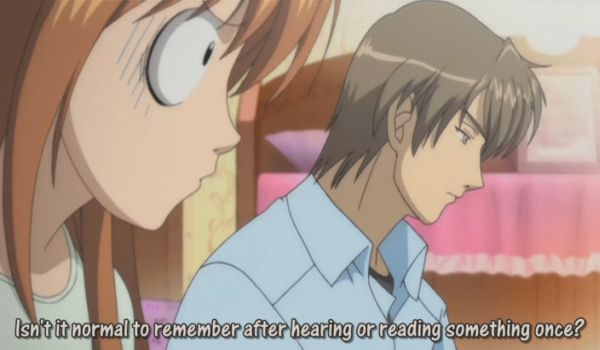Wednesday 27 August 2008

|
Pic of the day: No, it is not normal even in Japan to remember things after reading them only once. It would certainly come in handy though. Land of the rising IQ?It is hard to look at a Japanese web site and not get the impression that their life is an ongoing IQ test. I can certainly believe that east Asians are more intelligent than us Europeans: The selection pressure for brains must be extreme. I am led to believe that during school, children actually learn one kanji (word symbol) each schoolday, or very nearly so: They first learn hiragana and katakana (two different "alphabets" where each sign represent a syllable, like "ru") and then from grade 1 through 6 learn 1006 kanji, word signs. Most of these are fiendishly complex, and they not only learn to read them, they learn to write them. The work continues in junior high school with a whopping 939 new characters. Unless their junior high school is really long, that is well over one a day. At that point, they should be able to read newspapers amd other everyday literature. There are still thousands of kanji left - roughly 50 000, although any one person is unlikely to be exposed to them all in a lifetime, unless it's their job. The good news is that anything that can be written with kanji can also be written with hiragana OR katakana. Either of the two kindergarten scripts could last you for a lifetime, if not for the irrational need to keep using the word-script. In China, using signs for words actually makes sense, because the "dialects" inside China are more different than the languages in Europe. (But even Chinese signs has been bound to sounds for thousands of years though, according to other sources.) Japanese dialects are anyway far less diverse, and any Japanese can understand any other, although some find the Kansai dialect funny. (It is popularly used in fiction to make people stand out, much like southern dialects in the America.) Anyway, the point is that the use of kanji is either a way to keep existing literature readable, or a pure IQ test. Perhaps a combination of them. An old friend of mine who was doing research on dyslexia claimed that there are several forms of this affliction (and I made some software to help test people for those different forms). For instance, some people become unabletoreadtext ifthespacesgomissing, whi leoth ers arem orecon fus edbys pace sinth ewro ngpla ces. (I utterly hate the latter but is just slightly slowed by the former, for instance.) People like me recognize words by their shape, and this is so for the normal proficient reader. Given this, having separate signs for words (or root words at least) may actually be a good thing: The shape of words in English can only vary so much, given the limited raw materials. The shape of words in Japanese vary like crazy, so once you have learned them it should be faster to pick them out in a crowd. And indeed, some common forms of dyslexia are unknown in pictographic languages. See also this article (not by my friend). Japanese writing actually combines pictographic (or whatever you'd call it) with phonetic, since the root of words have separate signs while the endings and various grammar particles only have phonetic writing. In the picture I used, the final "ru" denotes the particular verb form used. I don't know if this combination means that both the English and the Chinese forms of dyslexia strike the poor Japanese, or on the contrary none fo them. Or an average of them? More research is needed, but not by me. As for whether Japanese really are genetically smarter than us, the jury is still out. Widespread literacy is so recent that even if there is a strong selection pressure toward reading and learning, it could not possibly have spread to the entire genome or even a large part of it yet. (Until the modern age, most people did not have books, nor the time to read them, much less go to school.) There is also another reason why it would be hard to notice the genetic difference between Asian brains and ours: The cultural difference would overshadow it. According to The Economist (and at least one other source, which I have forgotten because I am not Asian), Japanese children do as much homework in a day as American children do in a week! And I can think of a deeper reason for that. One of the first things you notice when trying to learn Japanese is the way the language itself favors humility. There are numerous forms - not just simple words, but variants of the language - that simply exist for the sake of politeness. When talking to strangers, special verb forms for humility are used about oneself and one's own group. Imagine that in the USA, world champion of self esteem! Where almost all parents are sure that their child is better than the average. (This is not entirely limited to the USA, I believe it was here in Norway that only 6% of parents considered their child to be below average. Then again we are one of the most Americanized countries in the world, despite our 25% sales tax.) In contrast, polls show that Japanese parents are frequently worrying about their kids' grades. America may be resting on its laurels now, but how well would they do if you packed them all together on a clammy mountain range in the middle of the sea, with no raw materials except fish and seaweeds? Well, think about it. Perhaps they too would do their homework then. As for my homework, that's what I meant to write about, but today's entry is already full.
|
Yesterday <-- This month --> Tomorrow?